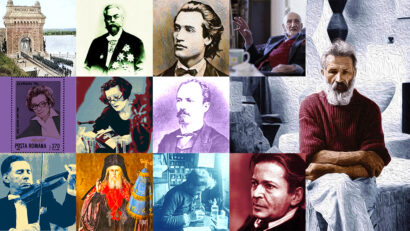Architects and Developers in Interwar Galati
First documented in 1445, the city of Galati has always been a major port on the Danube

Christine Leșcu, 24.04.2022, 01:37
First documented in 1445, the city of Galati has always been a major port on the Danube. Its most important period, when the city reached its peak, was the century between 1837 and 1938, when it was a free port, between 1837 and 1883, and then the seat of the European Commission of the Danube, up until 1938. In those 100 years, the city developed tremendously, becoming home not only to major banks, shipping agencies, international corporations, and consulates, but also to a large middle class. The most obvious signs of the refinement and wealth of this middle class are the buildings they fostered, many designed by famous Romanian and foreign architects, since Galati has always had a multicultural community. Unfortunately, several wars and the communist regime changed the city, but archives preserve the names of architects and their blueprints. A recently emerged name is that of Francisc Viecelli, a local architect of Italian descent, who designed several buildings in Galati that are emblematic for the citys wealth and its intense economic activity between the wars. Daniela Langusi made the discovery, and she told us about it:
“I dont think we could call him an architect. In 1932, on the basis of the new law of organization and functioning of the Corps of Architects, he applied for an architect license, but did not obtain it. However, there is a certificate issued by Galati City Hall, where we can see his name in full, Francesco Vittorio G. Viecelli. Obviously, an Italian name, since he was of Italian extraction. Surprisingly, he was born in the town of Filesti, in Covurlui County, meaning in the Galati area, since back then it was Covurlui County. He was born in 1891, and gained Romanian citizenship in 1933. Various documents and applications made by him lead us to deduce that he started working in 1919, when he was about 28. He was born in Romania, most likely from Italian parents. So, in 1933 he gains Romanian citizenship, and makes another application in 1935 to obtain the title of construction architect. Unfortunately, he is turned down a second time. He is only licensed as an authorized draft architect, which I suspect did not mean that he was a recognized design architect.”
Unfortunately, most of the buildings drafted by Viecelli are no longer standing, lost along with most of the historic old center of Galati. However, archive research reveals blueprints that could be used to envisage what the long gone buildings would have looked like. Art historian Daniela Langusi actually found of list of all the buildings that Francisc Viecelli worked on:
“We have nine private contracts and a factory. The factory was called Talpa, and it made footwear. It produced footwear for the army, soldier boots, military gear. In the archives in Galati I found the building permit from 1925. In the file we have the blueprints signed by Viecelli. They are included in the building permit. What is interesting is that when the factory applied for this building permit, it was specified that the works would be supervised by an engineer. The factory was on the edge of town, and that street was called Ditch Street. Now it is called George Cosbuc Boulervard, but back in Viecellis day it was called Ditch Street. However, what I would like to point out is the treatment of the windows, which were in a rectangular framing. He used this French type of window divided into panels. This architectural detail of style is to be found in his other works as well. The Talpa factory applied for the building permit in 1925 for a building with a ground floor and one story, with 350 sqm of living space, offices, and workshops.”
Archive research also gives us a glimpse into the past, into how the central area of Galati looked like, an area that was the venue for many of the buildings that Viecelli worked on. Daniela Langusi is here with details:
“There was round square that sprung six major avenues. One of them was Royal Avenue. Another major road that originated in Royal Square is to this day one of the citys major east-west axis streets. This central area of the city suffered bombing during WWII. After August 23, 1944, the German army, which had major headquarters in this area of town, thought it was a good idea to mine many of the buildings around these parts, and they were destroyed. After 1945, the authorities, in their attempt to restore the city, erected a completely different type of buildings, and in the process, that part of town was completely changed. It no longer has anything to do with what the city used to look like.”
In the place of the fashionable buildings of the past, the communists built drab apartment buildings. The old city, with its old streets, is no longer in the memory of the inhabitants of Galati. However, to this day, one of the buildings designed by Viecelli in the late 1920s has survived. It is a house initially designed for Cristache Teodoru, in the historic center of Galati, across from the Palace of Justice, built in the neo-Romanian style. It now houses the University of the Lower Danube. Daniela Langusi described the only standing building that was drafted by Francisc Viecelli:
“What can we say about it? We recognize the simple style, the window treatment in six asymmetric panels. However, here the framing of the windows is in a semicircle, it is no longer rectangular. I dont know if this was the requirement of the client, or if this is the only house where Vicelli chose to treat the windows in this fashion. We can also see the upper decorative girdle, a basrelief with floral and vegetation motifs. This building has been renovated. Also, the ground floor has a very high ceiling, with a special foundation for tall buildings. Its owner, barrister Cristache Teodoru, held the position of mayor of the city two times, between 1928 and 1931, also between 1932 and 1933.”
Unfortunately, not much else is known in detail about the Italian Romanian architect and builder Francisc Vicelli. Further research may uncover more about his activity, and about the Danube port city of Galati.






























